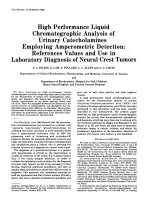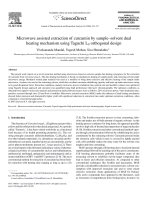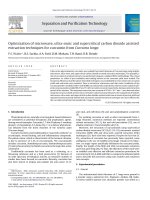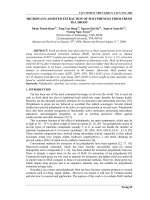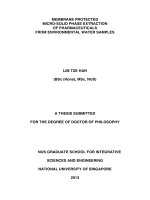High efficient column chromatographic extraction of curcumin from curcuma longa
Bạn đang xem bản rút gọn của tài liệu. Xem và tải ngay bản đầy đủ của tài liệu tại đây (382.33 KB, 4 trang )
Short communication
High-efficient column chromatographic extraction of curcumin from Curcuma longa
Pei-Yin Zhan
a
, Xue-Hua Zeng
a
, He-Ming Zhang
b,
⇑
, Hai-Hang Li
a,
⇑
a
Guangdong Provincial Key Laboratory of Biotechnology for Plant Development, College of Life Sciences, South China Normal University, Guangzhou 510631, China
b
Key Laboratory of China State Administration of Traditional Medicine for Chinese Medicine and Photonics Technologies, Institute of Traditional and Innovative Medicines,
South China Normal University, Guangzhou 510631, China
article info
Article history:
Received 16 December 2010
Received in revised form 20 February 2011
Accepted 22 April 2011
Available online 30 April 2011
Keywords:
Column chromatographic extraction
Curcumin
Turmeric
Curcuma longa
abstract
Curcumin is an important food additive and a potential therapeutic agent for various diseases from tur-
meric, the rhizome of Curcuma longa L. High-efficient column chromatographic extraction (CCE) proce-
dures were developed for the extraction of curcumin from turmeric. Turmeric powder was loaded into
a column with 2-fold 80% ethanol. The column was eluted with 80% ethanol at room temperature. For
quantitative analysis with a non-cyclic CCE, 8-fold eluent was collected as extraction solution. For large
preparation with a cyclic CCE, only the first 2-fold of eluent was collected as extraction and other eluent
was sequentially circulated to the next columns. More than 99% extraction rates were obtained through
both CCE procedures, compared to a 59% extraction rate by the ultrasonic-assisted maceration extraction
with 10-fold 80% ethanol. The CCE procedures are high-efficient for the extraction of curcumin from tur-
meric with minimum use of solvent and high concentration of extraction solution.
Ó 2011 Elsevier Ltd. All rights reserved.
1. Introduction
Curcumin is one of the important food additives for spice and
natural pigment, from turmeric, the rhizomes of Curcuma longa L.
(Green et al., 2008). Recently, it has been shown to possess various
pharmaceutical functions, such as anti-inflammatory (Jurenka,
2009), anticancer (Fu & Kurzrock, 2010; Ravindran, Prasad, &
Aggarwal, 2009), anti-ageing (Sikora, Scapagnini, & Barbagallo,
2010), neuro-protection in Alzheimer’s disease (Bandyopadhyay,
Huang, Lahiri, & Rogers, 2010; Kulkarni & Dhir, 2010) and many
other functions (Heng, 2010; Zhou, Beevers, & Huang, 2011). It
has received considerable interest as a potential therapeutic agent
for the prevention of various diseases (Zhou et al., 2011).
Extraction of curcumin from plant materials are mainly based
on the maceration method with the combination of circulation,
ultrasonic, microwave, heating, pressure or enzyme treatment
(Braga, Leal, Carvalho, & Meireles, 2003; Green et al., 2008; Mandal,
Dewanjee, Sahu, & Mandal, 2009; Mandal, Mohan, & Hemalatha,
2008; Manzan, Toniolo, Bredow, & Povh, 2003). These methods re-
quire long extraction times, high energy consumption and large
volume of organic solvent, have low extraction efficiency and are
unsafe for thermo-sensitive substances (Green et al., 2008).
We have reported a high-efficient column chromatographic
extraction (CCE) procedure for the extraction of compounds from
biological materials (Ni, Zhou, Li, & Huang, 2009). The CCE method,
based on chromatographic theory and practice, combined tradi-
tional and recent new technologies in the extraction field, such
as maceration, leaching, dynamic and circulation. Target sub-
stances in biological materials are dissolved and eluted in columns
with minimum volume of solvent. Using this method, curcumin
was completely extracted from turmeric materials with only 2-fold
(through cyclic CCE) or 8-fold (through non-cyclic CCE) 80% etha-
nol at room temperature. The highly concentrated extraction solu-
tion can be easily concentrated with low energy cost.
2. Materials and methods
2.1. Materials
Turmeric, dried rhizomes of C. longa L., is products of Guizhou
Province, China, and is purchased from Guangzhou market of
Chinese medicine. The dried turmeric was ground and sieved;
material between 833 and 350
l
m was used for experiments. Cur-
cumin standard compound was purchased from Sigma company
(St. Louis, MO, USA). HPLC-grade solvents were purchased from
Burdick & Jackson Inc. (Muskegon, MI, USA). Food-grade of 95%
ethanol was used in all extraction experiments. Other analytical-
or biochemical-grade organic solvents and chemical reagents were
purchased from local suppliers.
2.2. Extraction methods
For ultrasonic-assisted macerating extraction as a control for
traditional extraction methods, 10 g of turmeric powder was
0308-8146/$ - see front matter Ó 2011 Elsevier Ltd. All rights reserved.
doi:10.1016/j.foodchem.2011.04.065
⇑
Corresponding authors. Tel./fax: +86 20 8521 7701 (H M. Zhang), tel./fax: +86
20 8521 2630 (H H. Li).
E-mail addresses: (H M. Zhang), (H H.
Li).
Food Chemistry 129 (2011) 700–703
Contents lists available at ScienceDirect
Food Chemistry
journal homepage: www.elsevier.com/locate/foodchem
extracted with a 10-fold excess volume of solvents (w/v) with
100-W ultrasonic treatment for 1 h, unless otherwise stated. The
extraction solution was centrifuged at 5000 g for 10 min, filtered
through a 0.45-
l
m membrane filter and analysed by HPLC.
CCE procedure was performed in glass chromatographic
columns as described previously (Ni et al., 2009). Given amounts
of solvents were loaded into a column (1.5 cm diameter). Turmeric
powder (20 g) was then gradually added and was allowed to sink
freely down into the solvent. A total of 2-fold volume of solvent,
based on the weight of the turmeric powder (v/w), was then loaded
onto the column. After 1 h, the column was eluted by common
procedures at a flow rate of 2 bed volumes (BVs)/h, and eluent
were collected in fractions, each with a solvent volume equal to
two times the sample weight (w/v). Curcumin content in each
fraction were then analyzed by HPLC.
For cyclic CCE, only the first fraction of eluent was collected as
the final extraction solution. The second fraction was used to
extract the next material, and the third fraction was used for
eluting the next column. Through the cyclic CCE method, the total
volume of final extracting solution was only two times the weight
of the dry material (v/w), while the columns were eluted three
times.
2.3. Determination of curcumin
HPLC determination of curcumin is based on our previous
report (Wu, Ni, Li, & Li, 2008) with some modification. A Shimadzu
SPD-20A HPLC system (Shimadzu, Japan) with LC-20AT UV detec-
tor, YMC-packed ODS column (250 mm  4.6 mm, 5
l
m) and ana-
lytical software was used for the analysis of curcumin. The mobile
phase was acetonitrile: 5% acetic acid aqueous solution (50:50, v/
v). UV detection wavelength is 425 nm. All samples were filtered
through 0.45-
l
m membrane filters before injection into the HPLC.
The curcumin peak in samples were identified by its retention time
and co-injection test with standard curcumin (Fig. 1A). Quantita-
tive analysis of curcumin was performed using the peak area based
on the standard curve.
All experiments were repeated at least three times, and the
results are given as the mean of three independent experi-
ments ± standard error.
3. Results and discussion
The CCE method consists of two steps, dissolving target
compounds into the extraction solvent and eluting them from
the material in a chromatographic column. The key point for the
first step is to find a good solvent to dissolve target compounds
(Ni et al., 2009).
Using the traditional macerating method, the extraction
efficiencies of different concentrations of ethanol was tested. As
shown in Fig. 1B, the extraction rates of curcumin increased with
ethanol concentrations from 40% to 80%, with the highest extrac-
tion at 80%, but decreased when the ethanol concentration was
higher than 80%. The best solvent for dissolving curcumin from
turmeric was 80% ethanol.
To determine a minimum volume of solvent for the extraction
of curcumin from turmeric, five-fold excesses of 80% ethanol was
added to and mixed with the turmeric powder, the remained
solvent (not absorbed by the material) was determined each
15 min after start. As shown in Fig. 1C, turmeric material was fully
Fig. 1. Conditions for the extraction of curcumin from turmeric. A: Identification of curcumin peak in HPLC spectrum of extracted sample by co-injection test with standard
compound. Three peaks from left to right in the sample’s HPLC spectrum are bisdemethoxycurcumin, demethoxycurcumin and curcumin, respectively. B: Extraction of
curcumin from turmeric with different concentrations of ethanol. C: Absorbance of the solvent by turmeric powder. D: Effect of macerating hours on the extraction of
curcumin from turmeric.
P Y. Zhan et al. / Food Chemistry 129 (2011) 700–703
701
imbibed in 80% ethanol within 30 min, and it absorbed a maximum
volume of 1.2-fold its own weight. For operating purpose, we use
2-fold volume of solvent as minimum volume for extraction of
curcumin from turmeric.
Fig. 1D shows the effect of pre-macerating time on the dissolv-
ing of curcumin in 80% ethanol. Dissolution of curcumin from
turmeric into solvent reached a dynamic balance within 1 h.
Based on the results above, the conditions for extraction of
curcumin from turmeric by CCE procedure was determined as
follows. Turmeric material was loaded with 2-fold of 80% ethanol
into a column at a height-to-diameter (H/D) ratio of 10:1, pre-
dissolved target substances for 1 h and then eluted the column
with 80% ethanol at a flow rate of 2 BVs/h, all at room temperature.
Eluent was collected in fractions each with 2-fold volume of the
material weight and analyzed by HPLC.
As shown in Fig. 2A, curcumin was completely eluted from the
column within the first 4 fractions (8-fold volume of material
weight) of eluent. After then, curcumin could not be detected by
HPLC in the following fractions. Also, no curcumin could be
extracted from the material in the column by the ultrasonic-assisted
maceration extraction.
To low down the extraction solution and increase the concentra-
tion of the target compounds in large and continuous production of
extracts, a cyclic CCE procedure was tested. In this procedure, only
the first fraction of 2-fold eluent, which contained more than 80% of
curcumin, was collected as extraction, the second and third frac-
tions were circulated sequentially to the next column. As shown
in Fig. 2B (black bar) and Table 1, the extraction rate of curcumin
reached more than 99%. This result indicate that curcumin was
completely extracted from the material through the cyclic CCE
procedure with only 2-fold 80% ethanol which was circulated three
times among different columns from low to high contents of curcu-
min. The cyclic chromatographic extraction reduced extensively
the volumes of the solvent and the final extraction solution with
high extraction efficiency. Similar results were obtained when the
scale of extracting experiment was enlarged 100 times in the cyclic
CCE procedure.
Based on the results above, curcumin can be effectively
extracted by the CCE or cyclic CCE method in simple columns at
room temperature, with much higher extraction rates than the
ultrasonic-assisted macerating extraction (Table 1). The CCE
procedure, which used 8-fold solvent for complete extraction of
curcumin, is good for non-continuous extraction of samples in
quantitative analysis, while the cyclic CCE procedure has multiple
advantages for large scale and continuous extraction of curcumin
from turmeric materials.
4. Conclusions
A highly efficient CCE procedure was developed for the extrac-
tion of curcumin from turmeric. Turmeric material was loaded into
a column with 2-fold of 80% ethanol at a diameter-to-height ratio
of 1:10. After 1 h for dissolving target compounds, the column was
eluted with 80% ethanol at a flow rate of 2 BVs/h. For non-cyclic
CCE procedure, 8-fold of eluent was collected, while for cyclic
CCE procedure, only the first 2-fold of eluent was collected as
extraction solution. A more than 99% extraction rate for curcumin
was obtained in both procedures, compared to a 59% extraction
rate through the ultrasonic-assisted extraction with 10-fold of
80% ethanol. The CCE procedure is good for non-continuous extrac-
tion of samples in quantitative analysis, while the cyclic CCE proce-
dure has multiple advantages for large scale and continuous
extraction of curcumin. Results indicated that the CCE procedures
are highly efficient extraction methods for curcumin from
turmeric, with minimum use of solvent, minimum volume and
high concentration of extraction solution.
Acknowledgments
This work was supported by The Science and Technology
Supporting Programs of Guangzhou Municipal Government
(2008Z1-E591), Panyu District Science and Technology Programs
of Guangzhou City (2009-T-17-1) and Guangdong Natural Science
Fund (10151063101000002).
References
Bandyopadhyay, S., Huang, X., Lahiri, D. K., & Rogers, J. T. (2010). Novel drug targets
based on metallobiology of Alzheimer’s disease. Expert Opinion on Therapeutic
Targets, 14, 1177–1197.
Braga, M. E., Leal, P. F., Carvalho, J. E., & Meireles, M. A. (2003). Comparison of yield,
composition, and antioxidant activity of turmeric (Curcuma longa L.) extracts
obtained using various techniques. Journal of Agricultural and Food Chemistry, 51,
6604–6611.
Fu, S., & Kurzrock, R. (2010). Development of curcumin as an epigenetic agent.
Cancer, 116, 4670–4676.
Fig. 2. Column-chromatographic extraction of curcumin from turmeric. A: Extrac-
tion of curcumin from turmeric through the CCE method with 80% ethanol, 2, 4, 6,
and 8 mean solvent volumes to material weight. B: Extraction of curcumin from
turmeric by the non-cyclic CCE with 8-fold 80% ethanol (white bars) and by the
cyclic CCE with 2-fold 80% ethanol in enlarged scales (black bar). The total volume
of extraction solution is 2-fold of the material.
Table 1
Extracting efficiency of curcumin from turmeric by different extraction methods.
Extraction method and condition Amount
extracted (mg/
g)
Extraction
rate (%)
Ultrasonic-assisted macerating extraction
with 10-fold 80% ethanol
12.44 ± 2.05 59.0 ± 16.5
Non-cyclic CCE procedure with 8-fold 80%
ethanol
20.95 ± 0.15 100.0 ± 0.5
Cyclic CCE procedure with 2-fold of 80%
ethanol
20.82 ± 0.25 99.4 ± 1.2
702 P Y. Zhan et al. / Food Chemistry 129 (2011) 700–703
Green, C. E., Hibbert, S. L., Bailey-Shaw, Y. A., Williams, L. A., Mitchell, S., &
Garraway, E. (2008). Extraction, processing, and storage effects on
curcuminoids and oleoresin yields from Curcuma longa L. grown in Jamaica.
Journal of Agricultural and Food Chemistry, 56, 3664–3670.
Heng, M. C. (2010). Curcumin targeted signaling pathways: Basis for anti-
photoaging and anti-carcinogenic therapy. International Journal of
Dermatology, 49, 608–622.
Jurenka, J. S. (2009). Anti-inflammatory properties of curcumin, a major constituent
of Curcuma longa: A review of preclinical and clinical research. Alternative
Medicine Review, 14, 141–153.
Kulkarni, S. K., & Dhir, A. (2010). An overview of curcumin in neurological disorders.
Indian Journal of Pharmaceutical Sciences, 72, 149–154.
Mandal, V., Dewanjee, S., Sahu, R., & Mandal, S. C. (2009). Design and optimization of
ultrasound assisted extraction of curcumin as an effective alternative for
conventional solid liquid extraction of natural products. Natural Product
Communications, 4, 95–100.
Mandal, V., Mohan, Y., & Hemalatha, S. (2008). Microwave assisted extraction of
curcumin by sample-solvent dual heating mechanism using Taguchi L9
orthogonal design. Journal of pharmaceutical and biomedical analysis, 46,
322–327.
Manzan, A. C., Toniolo, F. S., Bredow, E., & Povh, N. P. (2003). Extraction of essential
oil and pigments from Curcuma longa [L] by steam distillation and extraction
with volatile solvents. Journal of Agricultural and Food Chemistry, 51, 6802–6807.
Ni, H., Zhou, X. H., Li, H. H., & Huang, W. F. (2009). Column chromatographic
extraction and preparation of cordycepin from Cordyceps militaris waster
medium. Journal of Chromatography B, 877, 2135–2141.
Ravindran, J., Prasad, S., & Aggarwal, B. B. (2009). Curcumin and cancer cells: How
many ways can curry kill tumor cells selectively? American Association of
Pharmaceutical Scientists Journal, 11, 495–510.
Sikora, E., Scapagnini, G., & Barbagallo, M. (2010). Curcumin, inflammation, ageing
and age-related diseases. Immunity and Ageing, 7,1.
Wu, B., Ni, H., Li, H. H., & Li, L. (2008). SPE-HPLC quantification of curcumin in
different cultivars and organs of ginger, Zingiber officinale Roscoe. Natural
Product Research and Development, 20, 859–862.
Zhou, H., Beevers, C. S., & Huang, S. (2011). The targets of curcumin. Current Drug
Targets, 12(3), 332–347.
P Y. Zhan et al. / Food Chemistry 129 (2011) 700–703
703
